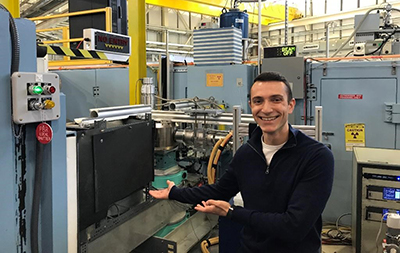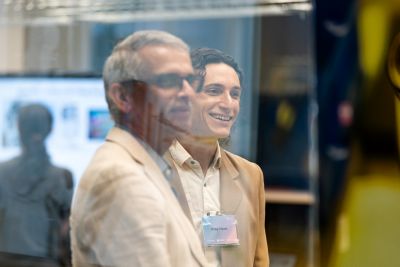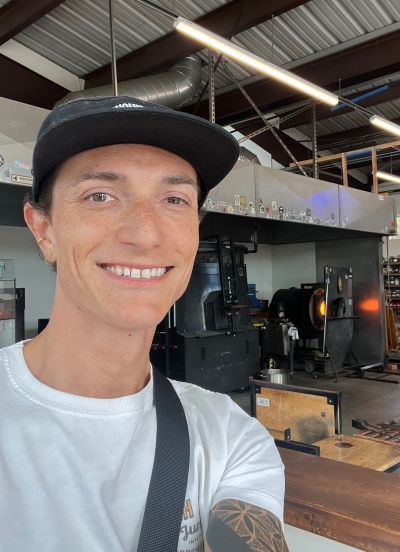Making Magic with Material Science and Mentorship
Riley Need, a research specialist at UC San Diego’s Qualcomm Institute, is driven by a voracious appetite for knowledge.
Published Date
Story by:
Media contact:
Topics covered:
Share This:
Article Content
Riley Need's scientific curiosity is omnivorous. They're utterly enthralled by the sheer volume of questions that science is trying to answer.
That's why, whenever they walk into a poster session or learn about a new project a colleague is working on, they want to be involved with everything—whether quantum devices, ceramics, solar panels or something in between.
"I think all science is cool," Need said. Need, who uses they/them pronouns, is a research specialist at UC San Diego's Qualcomm Institute (QI), where they support faculty from around QI and beyond with writing complex, multi-institutional grant proposals and designing ambitious programs for research, education and workforce development.
"I love going to big conferences and seeing what everyone is working on, and I just keep thinking, 'Wow, I can't believe people are working on that' or 'I never would have thought to ask that question, but it's such a cool question and I want to know the answer.'"
While Need's background lies in material science, their role at QI touches quantum information science, advanced materials, semiconductors and more.
From superconductors to solar panels and back again
Need’s journey to their current role was rewarding, if not always easy. While it might seem like it in retrospect, material science wasn't always the obvious choice.
"As an 18-year-old, I certainly did not know where I wanted to go," Need said, grinning as they reminisced on their early days at Clemson University and adding that "most 18-year-olds I've met don't have the clearest conception of that."

Still, their interest was piqued during an engineering seminar course when a material scientist froze a racquetball with liquid nitrogen and threw it at the ground, shattering it. Another presentation used superconductors to illustrate on a small-scale how maglev trains work using magnetic levitation (hence the name).
The department "had the coolest demos," Need explained, "and I had to know how it worked…Once I learned that material science is really the intersection of physics, chemistry, biology and engineering, I loved it even more because of how it takes concepts from these core science disciplines and fundamental parts of the natural world and applies them to solve problems in the way engineers do."
That interest in finding the real-world impacts of science evolved into a desire to tackle climate change. After summer internships at the National Institute for Technology and Los Alamos National Laboratory, Need went to UC Santa Barbara for grad school with the intent of focusing on solar energy and green tech.
“I wanted to learn more about semiconductors to figure out how to make better solar panels,” they explained.
But after Need arrived in Santa Barbara in 2012, they quickly learned that what solar technology required to implement at scale was cost-efficiency of construction and operation—the materials were already good enough. Instead, to stay close to semiconductors and their role in green technology, Need spent their graduate studies researching thermoelectrics, which use semiconductors to capture waste heat and convert it back into electricity, and magnetic thin films, which find application in emerging energy-efficient circuitry.
Changing coasts, changing phases
After graduate school and before landing in La Jolla last September, Need spent five years as faculty in the Materials Science and Engineering Department at the University of Florida in Gainesville, where they ended up showing students the same maglev demonstration that they'd watched at Clemson years earlier. Their research group focused primarily on electronic and magnetic phase transitions in a class of materials known as transition metal oxides. These materials and their unique transitions can help create smaller, more efficient classical electronics and could pave the way for improved quantum computing.
Here's how it works.
"When we think about phase transition, that most commonly refers to the way matter transitions from liquid to solid or gas," Need said. But, they explained, electrons in solid materials can do the same thing. In some solids, like ceramic dinner plates, the electrons are all stuck “like a solid” to their atomic nuclei and can’t move around, making them electrical insulators with high resistance.

"It's a lot of hats to wear," they said. "You're a research scientist, grant writer, lab manager, student mentor and teacher all on the same day. My brain doesn't like to hop back and forth between things on the 15-to-30 minute timescale that that job path often requires."
They also thought supporting science at a systems level would be more personally and professionally fulfilling than pursuing a narrow research niche for years at a time: "I love education, and I wanted to remain a part of academia because I wanted to help create educational structures that are well-suited to help students be successful in the world we live in today, even if I wasn't working directly with them on a day-to-day basis."
That's how Need ended up at QI. Now, Need helps create programs and research opportunities that also give students opportunities.
At QI, Need's scientific expertise is applied to fostering collaboration around high-stakes, large-scale grant proposals focused on quantum computing, electrical engineering, material science and more.
They explained that coordinating and drafting proposals for research projects involving many professors across multiple institutions takes a lot of time that faculty members often don't have. Need's role is to lighten the load and act as the go-between and first drafter, often with QI grant proposal writer Molly Wofford.
"It's more in line with how I like to work, digest information and dream about new ideas," they said, adding that they now get to dive into new research more quickly and more often.
Climate, collaboration and cats
“There are lots of people I haven’t met on campus, and my door is always open to new collaborations—not just at UC San Diego, but anyone in the San Diego and SoCal ecosystem.”

Beyond QI, Need spends their days doing yoga, cooking up goodies from the farmer’s market and hanging out with their 15-year-old cat, Zucchini. They also try hard to leave a positive impact on the world through volunteering work with environmental groups doing habitat restorations and beach cleanups around San Diego.
“I got into all of this because of climate change, and I like working in the environment," they said. "While I often like just being a set of hands and directly cleaning up the planet, these days I also help several organizations with their grant-writing efforts."
Although still relatively new to QI, Need is eager to deepen ties across campus and beyond.
“There are lots of people I haven’t met on campus, and my door is always open to new collaborations,” they said, “not just at UC San Diego, but anyone in the San Diego and SoCal ecosystem.”
If you're interested in collaborating with QI on new projects or proposals in semiconductors, quantum computing or electronic material science, you can reach Riley Need at rneed@ucsd.edu.
Stay in the Know
Keep up with all the latest from UC San Diego. Subscribe to the newsletter today.




